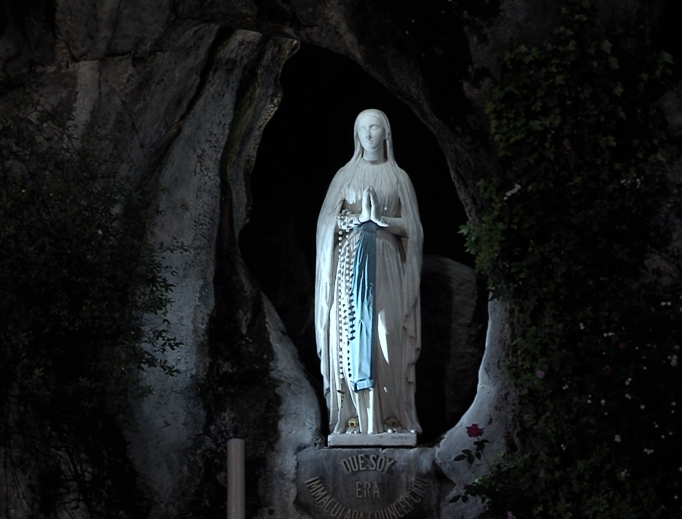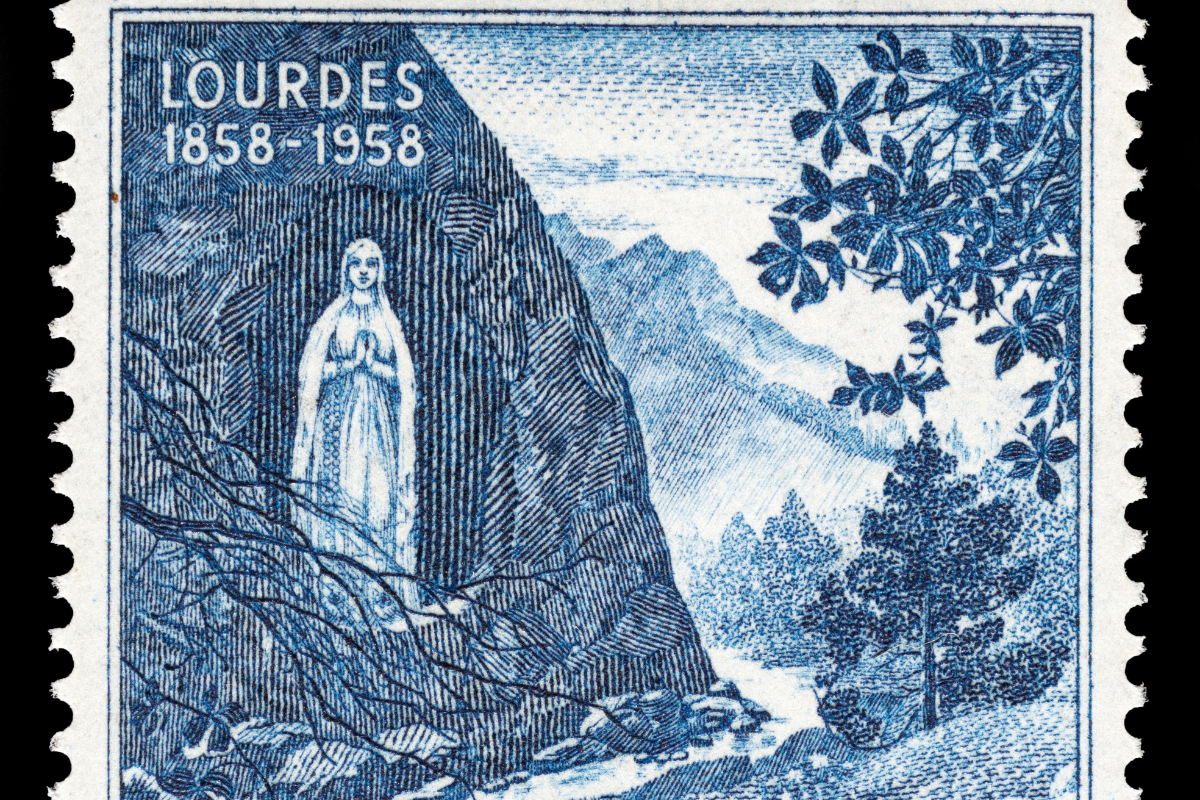Flannery O’Connor Was a Reluctant Pilgrim to Lourdes
O’Connor, writing to a priest friend, made a comment that revealed her compassion and humility: ‘The thing about Lourdes is that you are not inclined to pray there for yourself …’

Most people would be thrilled at the offer of a free trip to visit the Marian shrine at Lourdes. Still, this adventure entails plenty of travel, plus the ability to withstand herds of tourists. It is little wonder that, when Flannery O’Connor’s elderly cousin Katie offered to treat Flannery and her mother, Regina, to a diocesan pilgrimage, Flannery was quite reluctant to go.
After all, Flannery had been battling the effects of lupus since she was 25. Now 33, she was using crutches, which made traveling difficult. Also, she lived on a farm outside the city, where she counted on solitude and silence for her writing. The notion of being jostled about in a crowd was quite off-putting.
Add to this the fact that Flannery was a private person and couldn’t bear the thought of bathing in public. In her typically dry fashion, she described herself as someone who could “die for his religion easier than take a bath for it.”
Because of her deep-seated reservations, she viewed the prospect of the trip as a “comic nightmare.” Writing to a friend, she described her image of the journey as a planeload of “fortress-footed female Catholics” pushed from shrine to shrine. In another letter, she said she expected the pilgrims would be herded from holy place to holy place by Msgr. T. James McNamara to the point of holy exhaustion.

Initially, the trip was planned for April 22 to May 7, 1958, but much to Flannery’s relief, her doctors thought that would be too much for her. However, when she and Regina turned down their cousin’s offer, Katie was deeply disappointed, because she hoped Flannery would be healed from lupus. In the end, to appease Katie, a shorter trip was planned. As the itinerary was set up, Flannery wrote to a friend, “You’ll probably never catch me out of the confines of the United States again.”
Her descriptions of the trip were candid and often hilarious. She was dismayed when she was plagued early on by an infection and discovered that the only medicine available was whatever the leader of the pilgrimage, a monsignor, happened to have with him.
She was skeptical about the other “pilgrims” on the journey, whom she described as four old ladies who were always getting lost, four priests, two little boys, ages 12 and 14, two secretaries and “me and Ma.”
In her inimitable fashion, Flannery described one of the secretaries as if she were a character in a short story. According to Flannery, the red-haired lady from Albany, Georgia, who was about 26, wore three-inch high heels and was mostly interested in shopping. When asked about going to see a cathedral in Barcelona, the lady groaned and said, “Seen one, seen ’em all.”
Another woman, who hailed from Savannah, was terrified of flying and carried around a can of water from Lourdes, and “was always losing it, herself, everything else.” The little boys enjoyed torturing the woman by asking her, every time the plane hit turbulence, “Ready to crash?”
Flannery was extremely disappointed by the town of Lourdes, which had been turned into a major tourist attraction, which she described as “completely defaced by religious junk shops.” She was also annoyed by the many vendors, loudly hawking tacky religious paraphernalia on the streets.
Still, despite her negative views of the town, she did indeed bathe in the spring at Lourdes. She went very early in the morning, hoping to escape the crowds, and succeeded, since there were only about 40 people ahead of her.
She was dismayed by the lack of hygiene, as she watched people drinking from a communal cup of Lourdes water. Also, before entering the water, bathers donned a sack for modesty, but much to Flannery’s horror, the sack was the same one the person in front of you took off, regardless of the person’s ailment.
Even though Flannery finally did take the plunge, she objected when her friends praised her for it. She explained to them that her motives had been all wrong, since she had bathed to please her companions and to avoid feeling guilty.
Flannery later admitted that her prayers that day, as she entered the healing waters, weren’t for her physical health. Writing to a priest friend, she made a comment that revealed her compassion and humility: “The thing about Lourdes is that you are not inclined to pray there for yourself … as you see so many people worse off.” Instead, she prayed for her creativity to return, since she was having difficulties writing her second novel, The Violent Bear It Away.
One huge advantage of the trip was that the group headed to Rome after visiting Lourdes, and Flannery and her mother met Pope Pius XII. The Pope gave her a special blessing because of her crutches and impressed her deeply. She wrote, “Whatever the special superaliveness that holiness is, it is very apparent in him.”
The plane ride back to the United States exhausted her, although a little boy provided a diversion, when one of the men fell asleep with his mouth open, and the child pretended to insert a coin in it. She described her mother as gaining energy as soon as they were back in cow country.
Despite all her jokes, Flannery later admitted she took the bath at Lourdes because she believed that faith had to be acted out. Not too long after the trip, doctors noticed an improvement in her hip bone. She said she was willing to ascribe the improvement either to Lourdes or to somebody’s prayers — and in either case, she was grateful to God. Meanwhile, poor cousin Katie became gravely ill, but before died, she had the happiness of knowing the trip had helped Flannery’s health.
About five months after the trip, Flannery discovered her problems writing her novel had cleared up. Overjoyed, she believed her prayers at the shrine about creativity were being answered. When she finally completed the first draft of the novel she had been working on for years, she credited Lourdes more for this milestone than for her physical healing. She wrote, “Anyway, it means more to me.”
- Keywords:
- flannery o’connor
- lourdes
- our lady of lourdes
- spiritual healing
- physical healing
- world day of the sick
- lorraine murray
- lorraine v. murray

















